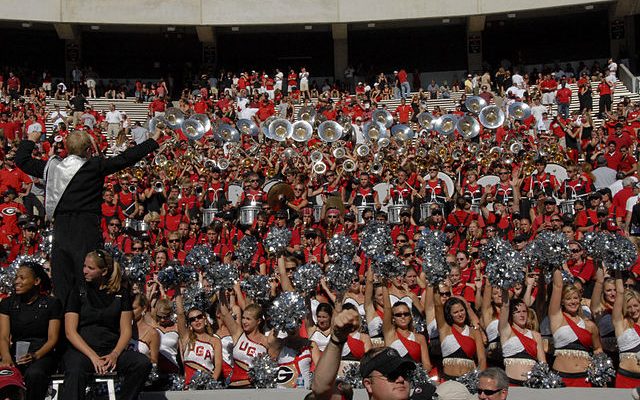The air in Sanford Stadium on a crisp autumn Saturday in 1959 was thick with a palpable sense of anticipation and hope, a feeling that had been building with every victory that season. The stands, a sea of wool coats, fedoras, and dresses, were packed to their then-capacity, the crowd a vibrant tapestry of Georgia fans who had endured more than a decade without a conference title. The collective roar was a primal sound, a surge of optimism that had been absent from Athens for too long. In the midst of this fervent crowd, standing with a disciplined posture and a gleam on their brass instruments, were the members of the Georgia Redcoat Band. Their scarlet jackets, bright against the backdrop of a stadium still largely built of concrete and brick, were a beacon of tradition, their music a pulsing heartbeat for the team and the fans alike. This was a moment in time captured not just in memory, but in the very fabric of the stadium itself—a snapshot of a fan base on the precipice of something truly special.
That 1959 season was a masterpiece of coaching and player grit, a triumph engineered by the legendary Wally Butts, who, in his final years at the helm, was searching for one last crowning achievement. The team was not built on overwhelming star power, but on a tenacious defense and a clutch offense led by quarterback Fran Tarkenton, a player whose improvisational genius and sheer will to win would become a hallmark of his long and celebrated career. Tarkenton, a future Hall of Famer, was the embodiment of the team’s spirit. He was quick, elusive, and utterly unflappable, a field general who could turn a broken play into a touchdown or a first down with an audacious scramble. He was a different kind of quarterback for a different time, a signal-caller who played with a modern flair in an era of conservative, run-heavy offenses. The fans in the stadium knew they were watching something unique, a player who could make them leap from their seats with a single, unexpected move.
The road to the SEC championship was far from easy. The season began with a dominant 17-0 victory over Alabama, a sign that this year might be different. But the defining moments came in a series of nail-biting, hard-fought contests that showcased the team’s resilience. The Bulldogs faced a tough Clemson team, a fierce rival from the Atlantic Coast Conference, in a game that was won on a dramatic late-game drive. They weathered a difficult road game against the Florida Gators, a contest that often defined the season’s success or failure, and came away with a crucial victory. Each win, no matter how narrow, was a building block, a piece of a larger puzzle that the team was slowly putting together. The Redcoat Band, playing its fight songs and marching with precision, was there for every step, their musical accompaniment a powerful underscore to the team’s relentless march toward glory. The sounds of “Glory, Glory to Old Georgia” echoed through the stadium, a chorus of faith and belief that grew louder with each passing week.
The stadium itself, in 1959, was a monument to college football’s growing prominence. While it was not the sprawling titan it is today, it was still a formidable and imposing venue. Its brick and concrete architecture gave it a timeless, classic feel, a place where generations of fans had gathered to cheer on their beloved Bulldogs. The crowd was a microcosm of Georgia society at the time. Men, in their pressed shirts and ties, and women, in their Sunday best, came from all corners of the state to be a part of the spectacle. It was a social event as much as it was a sporting one, a chance for people to connect, to share in a common passion. The air, crisp with the scent of autumn and the smoke from distant barbecue stands, was charged with an energy that was uniquely Southern and distinctly Georgian. Children sat on their parents’ laps, their eyes wide with wonder, dreaming of one day wearing the red and black. It was more than a game; it was a ritual, a sacred tradition.
The Redcoat Band, founded in 1905, was an integral part of this ritual. In 1959, they were a polished and professional unit, known for their elaborate halftime shows and their powerful presence in the stands. They were a team in their own right, practicing for countless hours to perfect their music and their intricate marching formations. Their uniforms—the striking scarlet jackets, white trousers, and shakos—made them instantly recognizable. Their role was to not only provide entertainment, but to be a motivator, a force that could lift the spirits of the crowd and, by extension, the players on the field. The music they played was a mix of traditional fight songs, popular tunes of the day, and rousing marches that filled every corner of the stadium. For a fan in the stands, their performance was a vital part of the game day experience, a tradition that was as important as the game itself.
The culmination of the season came in a high-stakes showdown that would decide the SEC title. The Bulldogs, against all odds, defeated a powerful Auburn team in a memorable game that sealed their fate. The victory was a long-awaited moment of triumph, a joyous release for a fanbase that had waited so patiently. The scene in the stadium after the final whistle was one of pure, unbridled celebration. The crowd rushed the field, a spontaneous outpouring of emotion. The Redcoat Band played “Glory, Glory” with a ferocity they had never before mustered, their music a joyous, celebratory cry that echoed through the night. It was a moment of collective happiness, a shared memory that would be passed down through generations. For the fans who were there, the season was a testament to the power of belief, to the magic that could happen when a team and a community came together for a common goal.
The 1959 SEC championship was more than just a trophy; it was a cultural touchstone for the state of Georgia. It marked a new era of success for the football program, setting the stage for future triumphs under legendary coaches. The legacy of that season, and the players who made it happen, is still felt today. When fans fill Sanford Stadium on a Saturday afternoon, they are not just watching a game; they are participating in a tradition that was forged in moments like those of 1959. They are part of a lineage that stretches back to that determined team, to that passionate crowd, and to the unwavering sound of the Redcoat Band. It is a connection to a simpler time, a time when college football was a community event that brought an entire state together. The memories of that season live on, a testament to the enduring power of sports to create moments of shared history that transcend generations.



